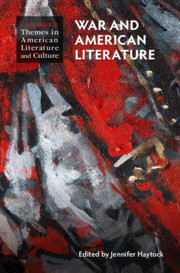32 results
Contents
-
- Book:
- War and American Literature
- Published online:
- 20 January 2021
- Print publication:
- 04 February 2021, pp v-vii
-
- Chapter
- Export citation
Further Reading
-
- Book:
- War and American Literature
- Published online:
- 20 January 2021
- Print publication:
- 04 February 2021, pp 345-356
-
- Chapter
- Export citation
Index
-
- Book:
- War and American Literature
- Published online:
- 20 January 2021
- Print publication:
- 04 February 2021, pp 357-374
-
- Chapter
- Export citation
Part III - New Lines of Inquiry
-
- Book:
- War and American Literature
- Published online:
- 20 January 2021
- Print publication:
- 04 February 2021, pp 269-344
-
- Chapter
- Export citation
Acknowledgments
-
- Book:
- War and American Literature
- Published online:
- 20 January 2021
- Print publication:
- 04 February 2021, pp xiii-xiii
-
- Chapter
- Export citation
Part II - Cultural Moments and the American Literary Imagination
-
- Book:
- War and American Literature
- Published online:
- 20 January 2021
- Print publication:
- 04 February 2021, pp 119-268
-
- Chapter
- Export citation
Copyright page
-
- Book:
- War and American Literature
- Published online:
- 20 January 2021
- Print publication:
- 04 February 2021, pp iv-iv
-
- Chapter
- Export citation
Part I - Aspects of War in American Literature
-
- Book:
- War and American Literature
- Published online:
- 20 January 2021
- Print publication:
- 04 February 2021, pp 11-118
-
- Chapter
- Export citation
Chapter 3 - Representing Soldiers
- from Part I - Aspects of War in American Literature
-
-
- Book:
- War and American Literature
- Published online:
- 20 January 2021
- Print publication:
- 04 February 2021, pp 42-56
-
- Chapter
- Export citation
Contributors
-
- Book:
- War and American Literature
- Published online:
- 20 January 2021
- Print publication:
- 04 February 2021, pp viii-xii
-
- Chapter
- Export citation
Chronology
-
- Book:
- War and American Literature
- Published online:
- 20 January 2021
- Print publication:
- 04 February 2021, pp xiv-xx
-
- Chapter
- Export citation
Chapter 10 - Americans in France
- from Part II - Settings and Subjects
-
-
- Book:
- A History of American Literature and Culture of the First World War
- Published online:
- 23 January 2021
- Print publication:
- 04 February 2021, pp 153-164
-
- Chapter
- Export citation
Introduction
-
-
- Book:
- War and American Literature
- Published online:
- 20 January 2021
- Print publication:
- 04 February 2021, pp 1-10
-
- Chapter
- Export citation

War and American Literature
-
- Published online:
- 20 January 2021
- Print publication:
- 04 February 2021
Part III - Wharton on the Margins
-
- Book:
- The New Edith Wharton Studies
- Published online:
- 28 November 2019
- Print publication:
- 19 December 2019, pp 111-172
-
- Chapter
- Export citation
Acknowledgments
-
- Book:
- The New Edith Wharton Studies
- Published online:
- 28 November 2019
- Print publication:
- 19 December 2019, pp xi-xi
-
- Chapter
- Export citation
Bibliography
-
- Book:
- The New Edith Wharton Studies
- Published online:
- 28 November 2019
- Print publication:
- 19 December 2019, pp 231-246
-
- Chapter
- Export citation
Notes on Contributors
-
- Book:
- The New Edith Wharton Studies
- Published online:
- 28 November 2019
- Print publication:
- 19 December 2019, pp vii-x
-
- Chapter
- Export citation
Contents
-
- Book:
- The New Edith Wharton Studies
- Published online:
- 28 November 2019
- Print publication:
- 19 December 2019, pp v-vi
-
- Chapter
- Export citation
Part IV - Sex and Gender Revisited
-
- Book:
- The New Edith Wharton Studies
- Published online:
- 28 November 2019
- Print publication:
- 19 December 2019, pp 173-230
-
- Chapter
- Export citation



